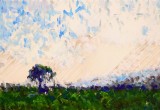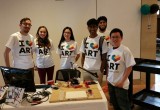$100,000 International Contest Seeking World's Most Artistic Robot Open to Public Voting

United States, April 18, 2016 (Newswire.com) - As the inaugural $100,000 RobotArt.org competition opens up to public voting, teams from around the world hope that their painting robot will take the title of most artistic machine.
Over a dozen teams, from six different countries, have all submitted artwork painted by a robot. Some of the work is abstract, while other paintings are representational, with several concentrating on portraiture. Some of the robots are operated manually while others are completely automated. The only thing that all the artwork has in common, is that each and every stroke was made by a robot. This is one of the only rules for this contest which is in its first of five annual contests.
"Fundamental to the competition is the belief that creativity and expression are emerging in unexpected ways from our relationship with technology. The contest hopes to explore and advance its development over the next five years."
Andrew Conru, Event Organizer
The team’s interests to robotic painting are as varied as the subject matter they have painted.
Italian Artist Patrick Tabarelli is “interested in producing original emotional visual experiences made by a machine but close to a human sphere of sensibility.”
Oliver Deussen and Thomas Lindemeier of Germany have used their robot platform eDavid to explore their interest “in non-photorealistic rendering, particularly in painterly rendering, paint simulation, machine learning and computational creativity.”
American Artist Pindar Van Arman is interested in capturing as much of his artistic process as possible in algorithms.
Other teams are focusing on the relationship between humans and robots. Carnegie Mellon’s Team A1 explores how much technology influences the creative process with their haptic robot arm. Ming-Jyun Hong of Taiwan made his painting robot to entertain and help people look for methods to ease their stress. Another robot lets anyone anywhere take control of it through a live crowdsourced web interface and paint images communally.
The form and function of the robots offer further variety. Multiple robots are the standard xy-plotting table or articulated 3D arm, though there are some unconventional robots such as one disguised as a plush snake, and another that appears to be holding dozens of brushes fanned out on a rotating disk. The robot with the most personality belongs to father/daughter team Artist-Bots. Their robot Billy resembles a miniature construction worker with a jackhammer on wheels, except the jackhammer is a brush leaving delicate outlines in its wake, instead of holes.
With the $100,00 contest in its inaugural year, the event’s organizer, Andrew Conru, hopes to build interest and a community behind the emerging field and genre of robotic art. As he puts it
“Fundamental to the competition is the belief that creativity and expression are emerging in unexpected ways from our relationship with technology. The contest hopes to explore and advance its development over the next five years.”
Voting is currently open to the public. Anyone interested in supporting the artists and their robots visit robotart.org to vote for their favorite.
For more information about the event feel free to contact its organizer and sponsor
Andrew Conru, Ph.D.
Entrepreneur, Engineer and Artist
abconru@yahoo.com
Source: Pindar Van Arman







